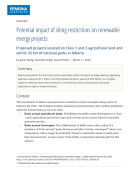A dozen renewable energy companies, industry associations and think-tanks released today the following open letter to the Alberta government:
October 24, 2016
Hon. Rachel Notley
Premier
307 Legislature Building
10800–97 Avenue
Edmonton, AB T5K 2B6
Hon. Margaret McCuaig-Boyd
Minister of Energy
324 Legislature Building
10800–97 Avenue
Edmonton, AB T5K 2B6
Hon. Shannon Phillips
Minister of Environment and Parks
208 Legislature Building
10800–97 Avenue
Edmonton, AB T5K 2B6
Re: A legislated target for renewable electricity in Alberta
Dear Premier Rachel Notley, Minister Margaret McCuaig-Boyd and Minister Shannon Phillips:
The Alberta government is developing the implementation mechanisms for the Climate Leadership Plan. We are asking the Alberta government to legislate a firm target for renewable energy in 2030 as part of this Act.
The case for the legislated target
While the Alberta government has demonstrated strong leadership via its Climate Leadership Plan, and a strong commitment to build renewables to reach 30 per cent of generation and replace coal generation, questions remain within the Alberta electricity market. How will this target be enforced? What considerations would lead to a deviation from this amount?
As a result, the case for the Alberta government to legislate a firm target to 2030 is a strong one: markets are most efficient where clear signals exist. The certainty of a long-term signal will provide a number of benefits including:
- Creation of a more stable energy market
- Increased competition
- Lower costs for renewables
- Creation of more stable, long-term and good paying jobs
- Better informed operations and lower power system costs for the Alberta Electric System Operator (AESO) and wires companies
Such a legislated target would demonstrate smart policymaking and enable Alberta to capture the full benefits from the commitment to renewables.
Certainty will create a stable energy market
A procurement strategy without legislation does not create a stable market. Legislated mandates turn informal commitments into formal obligations; any deviation from this commitment will require legislative action to unwind the scheduled increase in renewable energy penetration. This provides much greater certainty and a clear market signal, and is a very straightforward, easily administered and easily communicated way to establish goals and achieve them.
Long view of the market will increase competition
Successful procurement requires that more than a handful of companies participate in the market. While historic for Alberta’s electricity sector, the first round of the Renewable Electricity Program represents a modest market size for any renewable energy company evaluating the attractiveness of the Alberta market. The modest yearly size without any clear signal for additional annual procurements means that the decision to enter the market may be a ‘one-off’ power call. This is a boom or bust strategy that will limit competition and not lead to lowest-cost renewables.
Moreover, the modest size of each procurement round only increases risk on that capital investment since it is reasonable to expect that only a limited number of companies will be successful in a given round. Without a clear signal on the future market, players that were unsuccessful in a given round might decide to not participate in the future, and procurements could fail to acquire the necessary projects.
A legislated target would send a clear signal to developers that there is short-, mid- and long-term market potential, thereby increasing the likelihood that capital can be deployed for several rounds of procurement.
Lower costs for renewables
The increased competition from more companies’ involvement in procurement would result in lower price bids. Without sufficient participation, though, the competitive process risks overcharging Alberta for renewables.
More jobs created
A clear investment signal is needed for supply chain development investment decisions. While smaller individual procurement sizes may not justify a reorganization or rethink of existing supply chains, a clear indication of the long-term nature of the market could influence investment decisions differently. The more stable the renewable market size indicated by a legislated target, the more likely Alberta will be able to attract manufacturing jobs.
More so than many industries, the supply chain for renewables, including component manufacturing, requires a long-term commitment. It would be essentially impossible for a manufacturer to set up operations in the province on the basis of a yearly target. However, if market signals are clear, suppliers could see a significant local opportunity as well as potential to export into a global supply chain.
Similarly the fraction of construction jobs as well as head office jobs based in Alberta would be much higher and more stable under the larger market assured by a legislated target. Without the clarity of a legislated multiyear commitment, there is a risk that companies would keep Alberta operations to a minimum and with many of the jobs created in other jurisdictions.
Lowered system costs and improved operations for AESO
Yearly ministerial mandate letters provide neither the clear legal basis for action nor the long-term signal or expectation for AESO planning and action to implement policy. A legislated mandate — on the same level as the AESO’s other legal directions relating to the transmission system and power pool operations — provides the clear, unambiguous policy instruction that it seeks. Electricity infrastructure planning is multiyear and requires mid/long-term clarity to deliver reliability at the lowest cost.
Smart policymaking demonstrated
The approach of a market-based target follows the example of a number of similar deregulated electricity markets, giving reassurance that this is actually best practice for incenting renewables in this type of market. But the overwhelming majority of these approaches use a legislated target in their policy. There is a risk in using the best practices approach and not implementing all elements of the policy, as that element could be a critical component of making the policy successful.
Call to action
The Alberta government will be putting together legislation to create the Climate Leadership Act that will put in motion policy developed in the Climate Leadership Plan. As signatories of this letter we are asking the Alberta government to legislate the 30 per cent by 2030 target for renewables required to transition Alberta’s electricity supply mix away from coal.
Yours sincerely,
Enclosure: Additional Considerations








